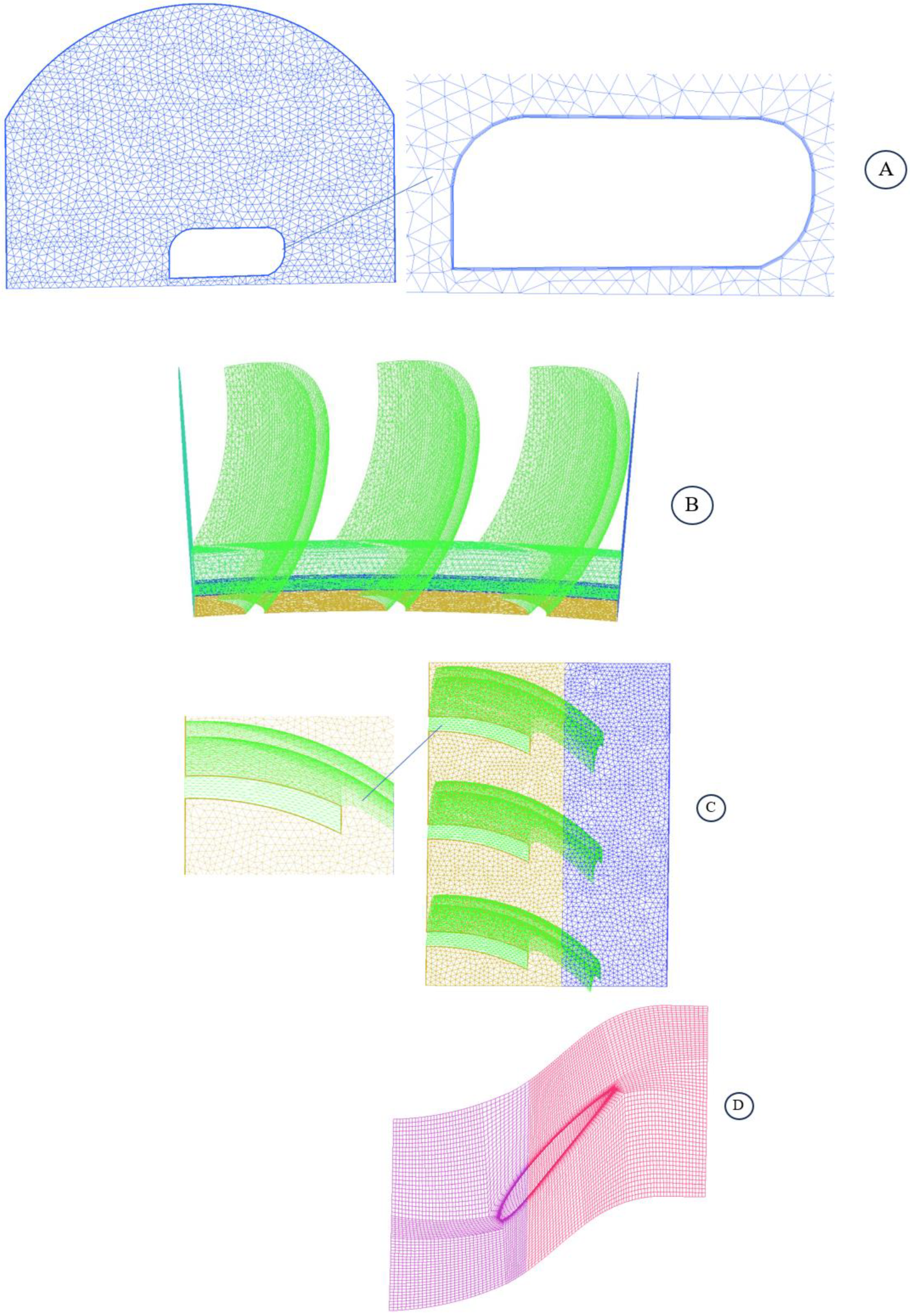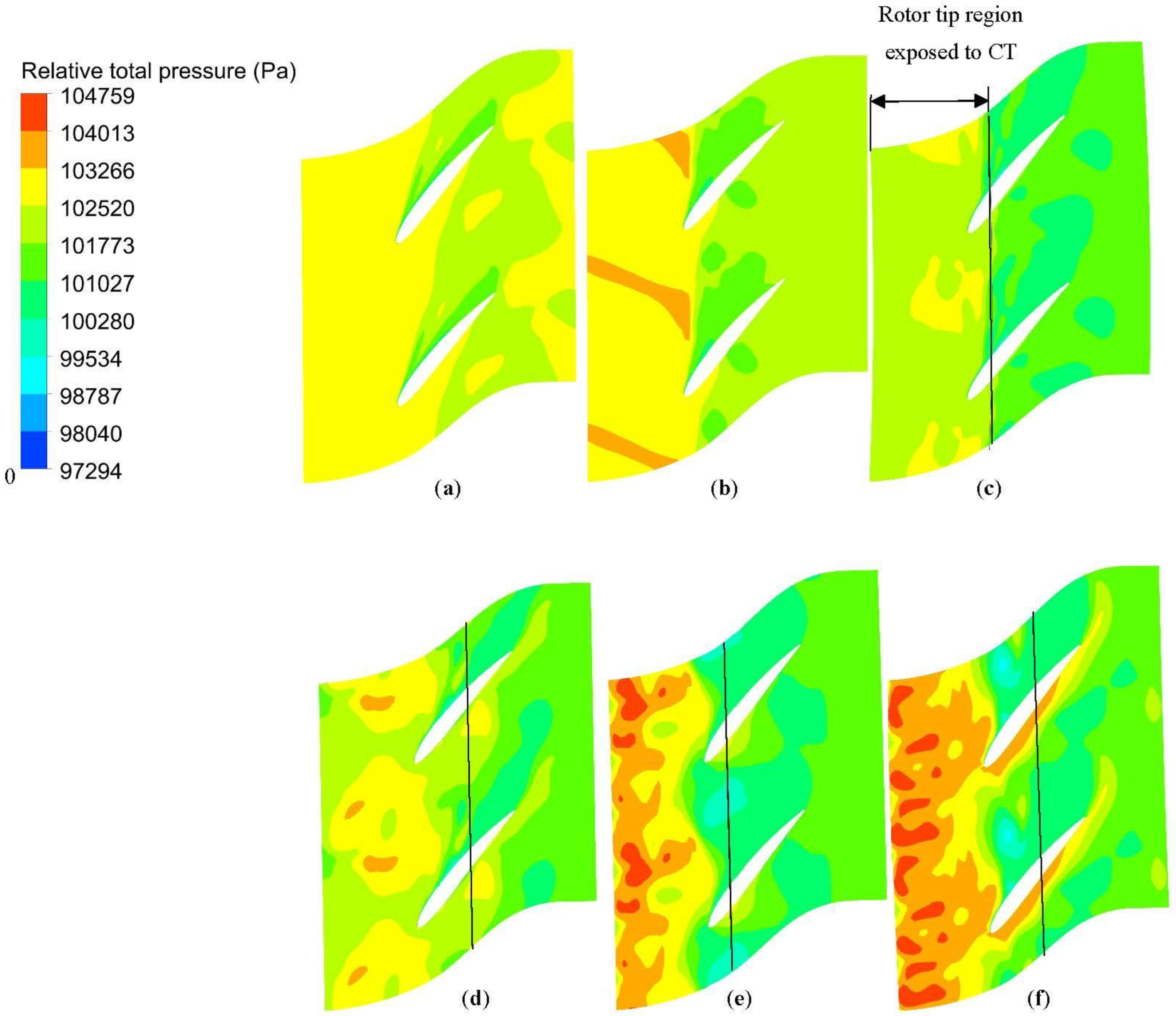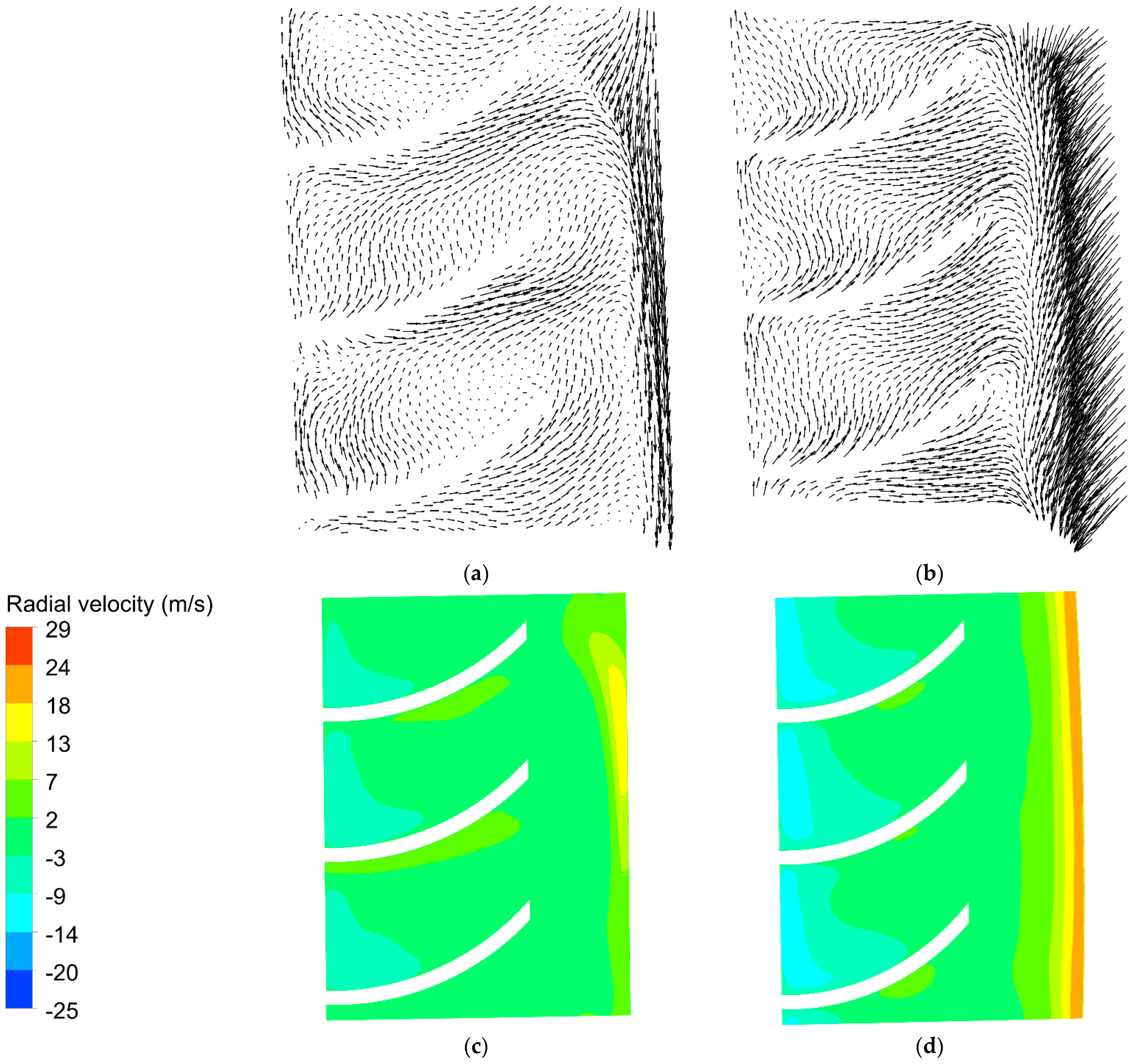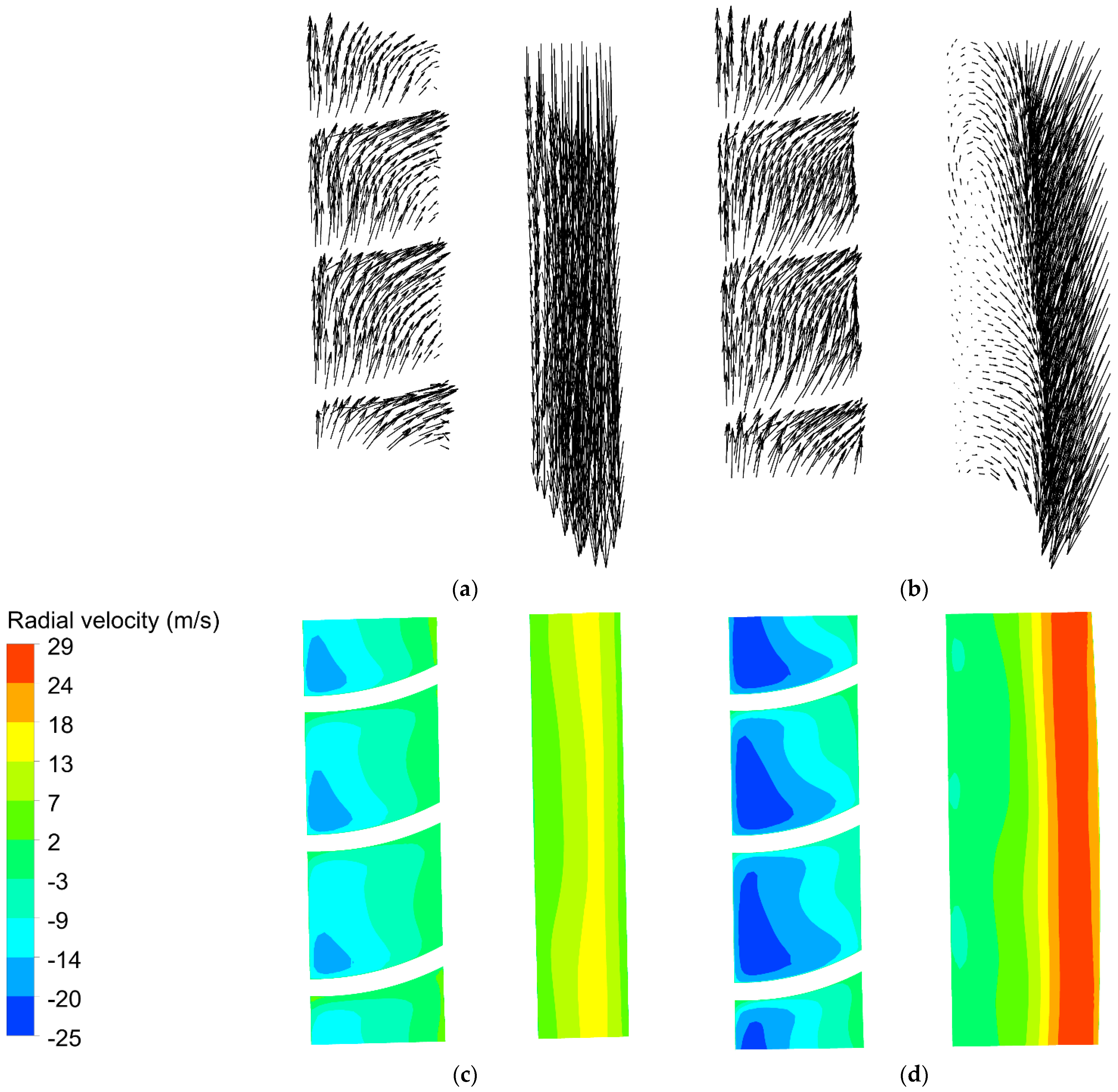Investigation of Vaned-Recessed Casing Treatment in a Low-Speed Axial Flow Compressor, Part I: Time-Averaged Results
Abstract
:1. Introduction
2. Investigated Compressor
3. Investigated Casing Treatment Configurations
4. Numerical Method
4.1. Governing Equations
4.2. Turbulence Model
4.3. Geometry
4.4. Boundary Conditions
4.5. Meshing Details
4.6. Grid Independence Study
4.7. Convergence Assessment
4.8. Stall Detection
4.9. Validation
5. Results
5.1. Compressor Characteristics
5.2. Rotor Flow Fields
5.2.1. Mach Number, Entropy and Pressure Distributions
5.2.2. Axial Velocity Profiles
5.3. Velocity Components and Velocity Triangles
5.3.1. Influence of Configuration A
5.3.2. Influence of Configuration B
| Configuration | SC-1.95 | CT-1.95 | CT-1.6 | |||||||
|---|---|---|---|---|---|---|---|---|---|---|
| Velocity Components (m/s) | ||||||||||
| Section | 1 | −0.24 | −54.1 | 12.7 | −1.9 | −65.1 | 16.4 | −5.7 | −74.7 | 14 |
| 2 | −1.4 | −49.4 | 6.6 | −0.1 | −63.6 | 14.3 | 3.5 | −71.8 | 8.3 | |
| 3 | 0.6 | −14.1 | −2.2 | 9.4 | −46.3 | 11.6 | 20.9 | −40 | 5.7 | |
| 4 | 0.1 | −8.2 | −9.2 | 11.8 | −39.7 | 10.2 | 21.1 | −1.7 | −17.8 | |
| 5 | 0.7 | −13.7 | 0.3 | 0.1 | −26.2 | 9.8 | 0.1 | −18.4 | 9 | |
| Configuration | CT-1.95 | CT-1.6 | ||||
|---|---|---|---|---|---|---|
| Velocity Components (m/s) | ||||||
| Inflow of the casing treatment | 3.6 | 5.7 | 7.5 | 8.4 | 12.8 | 2.2 |
| Outflow of the casing treatment | −2.2 | −2.6 | 8.8 | −9.2 | −11.1 | 6.1 |
5.4. Casing Treatment Flow Fields and Operating Mechanism
5.4.1. Velocity Vectors and Radial Velocity Distributions
5.4.2. Operating Mechanism of the Casing Treatment
5.5. Mechanism of Stall Margin Improvement
6. Conclusions
- (1)
- The two modifications to the traditional vaned recessed casing treatment relieve the accumulation of the low-speed fluid with less static pressure within the vane passages and in the corners of the vaned recessed casing treatment and could enhance flow recirculation.
- (2)
- The main function of the casing treatment was found to be to reduce the pressure gradient along the rotor blade and mostly close to the leading edge and, thus, the development of tip leakage vortex, which is responsible for the generation of low axial momentum fluid being reduced and weakened. Furthermore, the casing treatment also moves the tip leakage flow/main flow interface toward the trailing edge and, thus, delays the movement of the interface toward the leading edge, explaining how stability enhancement occurs.
- (3)
- Both configurations A and B reduce and eliminate reversed flows. However, configuration B with a larger exposure enables extra flow recirculation due to decreasing surface area and, therefore, could be superior to configuration A.
- (4)
- Both configurations A and B reduce the swirl component of absolute velocity. This may be accompanied by an increase in axial velocity. Moreover, the injected flow to the rotor blade tip has a swirl velocity component contrary to the rotor blade rotation. This gives the injected flow a great swirl velocity component in the relative frame of reference.
- (5)
- Three major streamlines and fluid trajectories were identified within the vaned recessed casing treatment: global flow recirculation, local vortex flow and half-ellipse flow. The evolutions of the three streamlines showed that the strength of these flow structures amplifies as the mass flow is reduced.
Author Contributions
Funding
Data Availability Statement
Conflicts of Interest
Nomenclature
| CAxial | Rotor blade tip axial chord |
| CD | Rotor blade tip axial chord exposure to the casing treatment |
| Cp | Specific heat at constant pressure (J/kg K) |
| CT | Casing treatment |
| CTA | Casing treatment, configuration A |
| CTB | Casing treatment, configuration B |
| C, W, U | Absolute, relative, blade velocity (m/s) |
| Time-averaged absolute swirl (circumferential) velocity component | |
| Cz | Axial velocity component (m/s) |
| Enthalpy (J) | |
| Mass flow rate (kg/s) | |
| NS | Near stall |
| P | Pressure (Pa) |
| PE | Peak efficiency |
| PR | Pressure ratio |
| PS | Pressure surface |
| Specific entropy (J/kg K) | |
| SC | Solid casing (no casing treatment) |
| SS | Suction surface |
| t-s | total condition-static condition |
| T | Temperature (K) |
| Rotor tip tangential velocity (m/s) | |
| Time-averaged radial velocity component (m/s) | |
| Time-averaged axial velocity component (m/s) | |
| Time-averaged relative swirl (circumferential) velocity component (m/s) | |
| Density (kg/m3) | |
| Mass flow rate (kg/s) | |
| Torque (N.m) | |
| Angular velocity (1/s) |
References
- Day, I. Active Suppression of Rotating Stall and Surge in Axial Flow Compressors. ASME J. Turbomach. 1993, 115, 40–47. [Google Scholar] [CrossRef]
- Suder, K.L.; Hathaway, M.D.; Thorp, S.A.; Strazisar, A.J.; Bright, M.M. Compressor Stability Enhancement Using Discrete Tip Injection. ASME J. Turbomach. 2001, 123, 14–23. [Google Scholar] [CrossRef]
- Strazisar, A.; Bright, M.; Thorp, M.; Culley, S.; Suder, K. Compressor Stall Control Through Endwall Recirculation. In Proceedings of the ASME Turbo Expo 2004: Power for Land, Sea, and Air, Vienna, Austria, 14–17 June 2004. ASME Paper 2004; GT2004-54295. [Google Scholar]
- Hathaway, M. Passive Endwall Treatments for Enhancing Stability; NASA Technical Report No. NASA/TM-2007-214409; Glenn Research Center: Cleveland, OH, USA, 2007. [Google Scholar]
- Azimine, A.R.; Elder, R.L.; McKenzie, A.B. Application of recess vaned casing treatment to axial flow fans. ASME J. Turbomach. 1990, 112, 145–150. [Google Scholar] [CrossRef]
- Ziabasharhagh, M.; McKenzie, A.B.; Elder, R.L. Recess vane passive stall control. In Proceedings of the International Gas Turbine and Aeroangine Congress and Exposition, Cologne, Germany, 1–4 June 1992. ASME Paper 1992; 92-GT-36. [Google Scholar]
- Kang, C.S.; McKenzie, A.B.; Elder, R.L. Recessed casing treatment effects on fan performance and flow field. In Proceedings of the ASME 1995 International Gas Turbine and Aeroengine Congress and Exposition, Houston, TX, USA, 5–8 June 1995. ASME Paper 1995; 95-GT-197. [Google Scholar]
- Akhlaghi, M.; Elder, R.L.; Ramsden, K.W. Effects of a vane-recessed tubular-passage passive stall control technique on a multistage, low-speed, axial-flow compressor: Results of tests on the first stage with the rear stages removed. In Proceedings of the ASME Turbo Expo 2003, collocated with the 2003 International Joint Power Generation Conference, Atlanta, GA, USA, 16–19 June 2003. ASME Paper 2003; GT2003-38301. [Google Scholar]
- Ghila, A.; Tourlidakis, A. Computational analysis of passive stall delay through vaned recess treatment. In Proceedings of the ASME Turbo Expo 2001: Power for Land, Sea, and Air, New Orleans, LA, USA, 4–7 June 2001. ASME Paper 2001; GT-0342. [Google Scholar]
- Yelmar, K.; Viswanath, K. Computational analysis of recess vane geometry modification in the casing treatment approach to enhance stall margin in axial flow fans. In Proceedings of the ASME 2013 International Mechanical Engineering Congress and Exposition, San Diego, CA, USA, 15–21 November 2013. ASME Paper 2013; IMECE2013-63096. [Google Scholar]
- Corsini, A.; Delibra, G.; Rispoli, F.; Sheard, A.G.; Volponi, D. Investigation on Anti-Stall Ring Aerodynamic Performance in an Axial Flow Fan. In Proceedings of the ASME Turbo Expo 2014: Turbine Technical Conference and Exposition, Düsseldorf, Germany, 16–20 June 2014. ASME Paper 2014; GT2014-25794. [Google Scholar]
- Bonanni, T.; Corsini, A.; Delibra, G.; Volponi, D.; Sheard, A.G. Modelling of Axial Fan and Anti-Stall Ring on a Virtual Test Rig for Air Performance Evaluation. In Proceedings of the ASME Turbo Expo 2016: Turbomachinery Technical Conference and Exposition, Seoul, Republic of Korea, 13–17 June 2016. ASME Paper 2016; GT2016-56862. [Google Scholar]
- Chen, X.; Chu, W.; Zhang, H.; Li, J.; Lang, J. Numerical investigation of effect of recess vane casing treatments on an axial lift fan performance. In Proceedings of the ASME Turbo Expo 2017: Turbomachinery Technical Conference and Exposition, Charlotte, NC, USA, 26–30 June 2017. ASME Paper 2017; GT2017-63767. [Google Scholar]
- Ghila, A.; Tourlidakis, A. Unsteady simulations of recess casing treatment in axial flow fans. In Proceedings of the ASME Turbo Expo 2006: Power for Land, Sea, and Air, Barcelona, Spain, 8–11 May 2006. ASME Paper 2006; GT2006-90388. [Google Scholar]
- Chen, X.; Chu, W.; Zhang, H.; Li, X. Numerical study on inlet angle of guide vane in recess vaned casing treatment. Aerosp. Sci. Technol. 2019, 93, 105323. [Google Scholar] [CrossRef]
- Akhlaghi, M. Application of a Vane-Recessed Tubular-Passage Casing Treatment to a Multistage Axial-Flow Compressor. Ph.D. Thesis, University of Cranfield, Cranfield, UK, 2001. [Google Scholar]
- Zori, L.; Galpin, P.; Campregher, R.; Morales, J.C. Time-transformation simulation of a 1.5 stage transonic compressor. ASME J. Turbomach. 2017, 139, 071001. [Google Scholar] [CrossRef]
- Cornelius, C.; Biesinger, T.; Galpin, P.; Braune, A. Experimental and computational analysis of a multistage axial compressor including stall prediction by steady and transient CFD methods. ASME J. Turbomach. 2014, 136, 061013. [Google Scholar] [CrossRef]
- Gourdain, N.; Burguburu, S.; Leboeuf, F.; Michon, G.J. Simulation of rotating stall in a whole stage of an axial compressor. Comput. Fluids 2010, 39, 1644–1655. [Google Scholar] [CrossRef]
- Akhlaghi, M.; Azizi, Y.; Nouri, N.M. Estimations of compressor stall and surge using passage stall behaviors. Machines 2022, 10, 706. [Google Scholar] [CrossRef]
- Vo, H.D.; Tan, C.S.; Greitzer, E.M. Criteria for Spike Initiated Rotating Stall. ASME J. Turbomach. 2008, 130, 011023. [Google Scholar] [CrossRef]

























| Parameter | Value |
|---|---|
| Number of IGV blades | 34 |
| Number of Rotor blades | 38 |
| Number of Stator blades | 37 |
| Rotor blade tip diameter | 405 mm |
| Rotor blade hub diameter | 284.4 mm |
| Tip clearance | 0.7 mm |
| Hub-to-tip ratio | 0.7 |
| Rotor blade chord | 30.5 mm |
| Rotor blade aspect ratio | 2.0 |
| Parameter | Value | |||||
|---|---|---|---|---|---|---|
| Grid type | Coarse-1 | Coarse-2 | Medium | Fine-1 | Fine-2 | |
| Total number of nodes | 791,713 | 1,101,803 | 2,224,443 | 5,085,835 | 10,565,038 | |
| Mass flow = 2.12 kg/s | Pressure (Pa) | 101,440 | 101,450 | 101,460 | 101,470 | 101,470 |
| Pressure rise coefficient (t-s) | 0.09 | 0.09 | 0.14 | 0.14 | 0.14 | |
| Pressure ratio (t-s) | 1.003 | 1.003 | 1.004 | 1.004 | 1.004 | |
| Mass flow = 1.95 kg/s | Pressure (Pa) | 101,580 | 101,600 | 101,630 | 101,630 | 101,630 |
| Pressure rise coefficient (t-s) | 0.12 | 0.12 | 0.16 | 0.16 | 0.16 | |
| Pressure ratio (t-s) | 1.004 | 1.004 | 1.005 | 1.005 | 1.005 | |
| Parameter | Experimental | Numerical | Error (%) | |
|---|---|---|---|---|
| Mass flow = 2.35 kg/s | Total pressure at inlet | 101,628 | 101,595 | 0.032 |
| Static pressure at outlet | 101,981 | 101,848 | 0.130 | |
| Total pressure at outlet | 102,722 | 102,578 | 0.140 | |
| Pressure ratio (t-s) | 1.003 | 1.002 | 0.051 | |
| Total pressure at inlet | 101,556 | 101,595 | 0.038 | |
| Mass flow = 2.12 kg/s | Static pressure at outlet | 102,157 | 102,001 | 0.152 |
| Total pressure at outlet | 102,777 | 102,651 | 0.122 | |
| Pressure ratio (t-s) | 1.006 | 1.004 | 0.199 | |
| Total pressure at inlet | 101,512 | 101,595 | 0.082 | |
| Static pressure at outlet | 102,206 | 102,103 | 0.101 | |
| Mass flow = 1.95 kg/s | Total pressure at outlet | 102,724 | 102,619 | 0.102 |
| Pressure ratio (t-s) | 1.007 | 1.005 | 0.199 |
| Parameter | Experimental | Numerical | Error (%) | |
|---|---|---|---|---|
| Mass flow = 1.95 kg/s | Total pressure at inlet | 100,281 | 100,570 | 0.288 |
| Static pressure at outlet | 100,980 | 101,096 | 0.115 | |
| Total pressure at outlet | 101,479 | 101,686 | 0.204 | |
| Pressure ratio (t-s) | 1.007 | 1.005 | 0.176 | |
| Mass flow = 1.6 kg/s | Total pressure at inlet | 100,293 | 100,540 | 0.246 |
| Static pressure at outlet | 101,091 | 101,193 | 0.101 | |
| Total pressure at outlet | 101,451 | 101,734 | 0.279 | |
| Pressure ratio (t-s) | 1.008 | 1.006 | 0.149 |
| Configuration | SC-1.95 | CT-1.95 | CT-1.6 | |||||||
|---|---|---|---|---|---|---|---|---|---|---|
| Velocity Components (m/s) | ||||||||||
| Section | 1 | −0.24 | −54.1 | 12.7 | −0.6 | −58.9 | 13.3 | −2.9 | −67.7 | 9.7 |
| 2 | −1.4 | −49.4 | 6.6 | 0.4 | −58.5 | 11.2 | 5.1 | −49.4 | 3.4 | |
| 3 | 0.6 | −14.1 | −2.2 | 0.5 | −28.8 | 0.6 | 1.1 | −10.2 | 1.9 | |
| 4 | 0.1 | −8.2 | −9.2 | 2.1 | −24.1 | −7.1 | 0.4 | −6.9 | −9.2 | |
| 5 | 0.7 | −13.7 | 0.3 | 0.6 | −18.2 | 2.9 | 0.2 | −12 | 3.4 | |
| Configuration | CT-1.95 | CT-1.6 | ||||
|---|---|---|---|---|---|---|
| Velocity Components (m/s) | ||||||
| Inflow of the casing treatment | 1.9 | 6.6 | 6.7 | 6.2 | 18.7 | −0.1 |
| Outflow of the casing treatment | −0.8 | −0.8 | 3.6 | −5.3 | −6.9 | 6.1 |
| Configuration | SC-1.95 | Configuration A CT-1.95 CT-1.6 | Configuration B CT-1.95 CT-1.6 | |||
|---|---|---|---|---|---|---|
| Section | 1 | 9.5 | 4.6 | −4.1 | −1.5 | −11 |
| 2 | 14.2 | 5.1 | 14.1 | 0 | −8.2 | |
| 3 | 49.4 | 34.7 | 53.3 | 17.3 | 23.5 | |
| 4 | 55.4 | 39.4 | 56.6 | 23.9 | 61.8 | |
| 5 | 49.8 | 45.3 | 51.6 | 37.3 | 45.1 | |
Disclaimer/Publisher’s Note: The statements, opinions and data contained in all publications are solely those of the individual author(s) and contributor(s) and not of MDPI and/or the editor(s). MDPI and/or the editor(s) disclaim responsibility for any injury to people or property resulting from any ideas, methods, instructions or products referred to in the content. |
© 2023 by the authors. Licensee MDPI, Basel, Switzerland. This article is an open access article distributed under the terms and conditions of the Creative Commons Attribution (CC BY) license (https://creativecommons.org/licenses/by/4.0/).
Share and Cite
Akhlaghi, M.; Azizi, Y. Investigation of Vaned-Recessed Casing Treatment in a Low-Speed Axial Flow Compressor, Part I: Time-Averaged Results. Aerospace 2023, 10, 764. https://doi.org/10.3390/aerospace10090764
Akhlaghi M, Azizi Y. Investigation of Vaned-Recessed Casing Treatment in a Low-Speed Axial Flow Compressor, Part I: Time-Averaged Results. Aerospace. 2023; 10(9):764. https://doi.org/10.3390/aerospace10090764
Chicago/Turabian StyleAkhlaghi, Mohammad, and Yahya Azizi. 2023. "Investigation of Vaned-Recessed Casing Treatment in a Low-Speed Axial Flow Compressor, Part I: Time-Averaged Results" Aerospace 10, no. 9: 764. https://doi.org/10.3390/aerospace10090764
APA StyleAkhlaghi, M., & Azizi, Y. (2023). Investigation of Vaned-Recessed Casing Treatment in a Low-Speed Axial Flow Compressor, Part I: Time-Averaged Results. Aerospace, 10(9), 764. https://doi.org/10.3390/aerospace10090764






